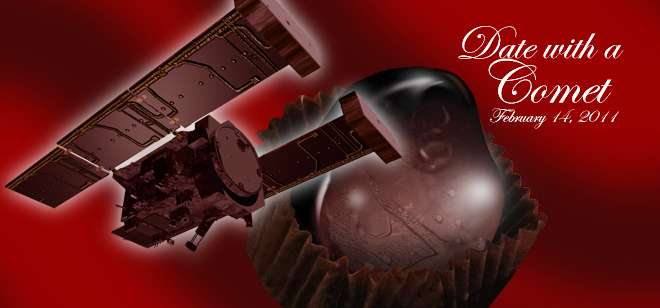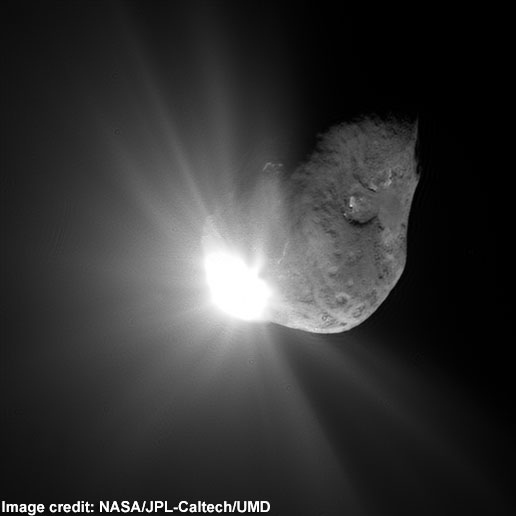5 Valentine's Day Facts About NASA's Comet Tempel 1 Flyby

NASA's Stardust spacecraft will zip close by the comet Tempel 1 tonight (Feb. 14) in a cosmic Valentine's Day rendezvous to take a new look at the icy wanderer.
The cosmic flyby will mark the second comet visited by the Stardust spacecraft – as part of its extended Stardust-NExT mission – as well as the second time an unmanned probe from Earth has approached Tempel 1.
In 2005, NASA's Deep Impact mission visited comet Tempel 1 and intentionally crashed a probe into the comet to determine its composition. Researchers hope tonight's Stardust flyby will give scientists a fresh look at the damage inflicted by the Deep Impact crash.
This factoid list, created by NASA and released by the agency's Jet Propulsion Laboratory, gives a brief look at some specifics of tonight's comet Tempel 1 flyby with a Valentine's Day flavor:
1) "The Way You Look Tonight" – The spacecraft is on a course to fly by comet Tempel 1 on Feb. 14 at about 8:37 p.m. PST (11:37 p.m. EST) – Valentine's Day. Time of closest approach to Tempel 1 is significant because of the comet's rotation. We won't know until images are returned which face the comet has shown to the camera.
2) "It's All Coming Back To Me Now" – In 2004, Stardust became the first mission to collect particles directly from a comet, Wild 2, as well as samples of interstellar dust.
The samples were returned in 2006 via a capsule that detached from the spacecraft and parachuted to the ground at a targeted area in Utah. Mission controllers then placed the still-viable Stardust spacecraft on a flight path that could reuse the flight system, if a target of opportunity presented itself. Tempel 1 became that target of opportunity.
Breaking space news, the latest updates on rocket launches, skywatching events and more!
3) "The First Time Ever I Saw Your Face" – The Stardust-NExT mission will allow scientists for the first time to look for changes on a comet's surface that occurred after one orbit around the sun.
Tempel 1 was observed in 2005 by NASA's Deep Impact mission, which put an impactor on a collision course with the comet. Stardust-NExT might get a glimpse of the crater left behind, but if not, the comet would provide scientists with previously unseen areas for study.
In addition, the Stardust-NExT encounter might reveal changes to Tempel 1 between Deep Impact and Stardust-NExT, since the comet has completed an orbit around the sun.
4) "The Wind Beneath My Wings" – This Tempel 1 flyby will write the final chapter of the spacecraft's success story.
The aging spacecraft approached 12 years of space travel on Feb. 7, logging almost 6 billion kilometers (3.5 billion miles) since launch. The spacecraft is nearly out of fuel. The Tempel 1 flyby and return of images are expected to consume the remaining fuel.
5) "Love Is Now the Stardust of Yesterday" – Although the spacecraft itself will no longer be active after the flyby, the data collected by the Stardust-NExT mission will provide comet scientists with years of data to study how comets formed and evolved.
NASA's live NASA TV broadcast and webcast of tonight's Valentine's Day comet flyby of Tempel 1 by the Stardust-NExT spacecraft will begin at about 11:30 p.m. EST (8:30 p.m. PST, 0330 Feb. 15). You can watch the webcast online live here: http://www.nasa.gov/ntv.
You can follow SPACE.com senior writer Mike Wall's coverage of Stardust-NExT's comet flyby on Twitter: @michaeldwall. Follow SPACE.com's comet coverage at @SpaceDotCom and on Facebook.

The National Aeronautics and Space Administration (NASA) is the U.S. government agency in charge of the civilian space program as well as aeronautics and aerospace research. Founded in 1958, NASA is a civilian space agency aimed at exploring the universe with space telescopes, satellites, robotic spacecraft, astronauts and more. The space agency has 10 major centers based across the U.S. and launches robotic and crewed missions from the Kennedy Space Center in Cape Canaveral Florida. Its astronaut corps is based at the Johnson Space Center in Houston. To follow NASA's latest mission, follow the space agency on Twitter or any other social channel, visit: nasa.gov.

